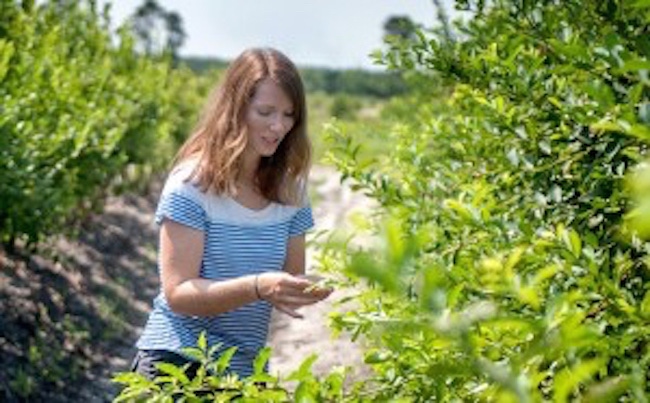
Funded by the college’s Plants for Human Health Institute, the new harvester has advanced technology that makes it much gentler on the fruit than older models and also more accurately represents the machines currently used by commercial growers. It employs two large beater heads with “fingers” that agitate to shake the berries loose.
July 13, 2015

It’s late in the growing season at the North Carolina State's College of Agriculture and Life Sciences’ Castle Hayne Research Station as blueberry breeder Maggie Schaber walks the rows, plucking the occasional berry and popping it into her mouth.
‘Hot’ doesn’t begin to describe this sweltering June morning. But the berries don’t seem to mind. Indeed, they’re plump and warm and delicious, delivering a little bit of the sun with each bite.
Parked at the end of one plot is a large mechanical harvester, and in the distance perches a new pack shed (painted N.C. State red and white, of course).
Both are recent acquisitions by the station and will aid Schaber’s work to develop blueberry varieties that can withstand the rigors of mechanical harvest.
“My job is to breed commercial cultivars,” Schaber says. “I really want the growers in this state to excel and provide the best product possible to consumers.”
Funded by the college’s Plants for Human Health Institute (PHHI), the new harvester has advanced technology that makes it much gentler on the fruit than older models and also more accurately represents the machines currently used by commercial growers. It employs two large beater heads with “fingers” that agitate to shake the berries loose.
“As great as this new technology is, there are still a number of issues with mechanical harvest,” Schaber says, “The growers need something that doesn’t bruise the fruit and that picks the blue fruit, not the green fruit."
Schaber’s work to breed a more resilient berry not only will aid the growers, but also will benefit the companies that design and manufacture the mechanical harvesters by providing insight into how their machines can best function.
In commercial operations, when the berries come out of the field, they have to endure even more handling on a mechanical sorting line. So, to replicate the berry’s entire journey from field to clamshell, Schaber and her team renovated an old storage barn into a functional pack shed and constructed a small-scale sorting line inside.
“Some of the equipment was donated to the university years ago and has been packed up in a shed,” says Castle Hayne Research Station Superintendent John Garner. “We brought it out, and Maggie was able to find funding for the other pieces. This was a shell of a building, with no interior walls. It looks like an entirely different place.”
The sorting line boasts two recently-acquired machines: a soft sorter, obtained by Schaber through a Dean’s Enrichment Fund grant, which uses sensor touch pads and compressed air to “pop” out berries that are overripe or bruised; and a color sorter, acquired through PHHI funding, that uses camera technology to kick out berries that aren’t blue.
To test a blueberry variety for its capacity to withstand mechanical harvest, Schaber first weighs the fruit picked by the harvester. Then, after it passes through the sorting line, she weighs it again, along with each of the different bins of reject berries.
“That gives me a percentage of what would not be commercially marketable, as well as an overall picture of how particular varieties would do in a setting like the growers use,” she says.
Nearly 70 percent of high-bush variety blueberries are still picked by hand, which is labor-intensive and expensive for growers.
“They’d experience huge savings — roughly 50 percent — with mechanical harvest, but the machine bruises the fruit, which then decreases the amount that actually goes to the consumer,” she says. “So if we can breed varieties that can withstand that beating, then more berries go to market and the growers experience better profit.”
The North Carolina Blueberry Council plays a big role in supporting the college’s blueberry breeding program. The organization funds Schaber’s salary and supports other aspects of her research. The council also provides grant opportunities for researchers throughout the Southeast.
“The blueberry breeding program at N.C. State is critical to the success of the industry in North Carolina,” says Julie Woodcock of the North Carolina Blueberry Council. “Maggie’s work has helped us gain ground, and we’re committed to doing anything we can to support the important work taking place out at the research station.”
Ralph Carter, a commercial blueberry grower and president of the council, agrees.
“Maggie does a great job visiting with the growers and listening to what our wants and needs are,” he says. “Breeding new varieties is the future of our industry, and North Carolina has been a leader in that because of the work happening at N.C. State and on the research station.”
While she develops and tests new varieties for mechanical harvest, Schaber also has her sights set on another big goal for the future.
“Americans have come to expect produce to be available 24/7,” she says. “Currently the United States supplies fresh blueberries from April through September, with the winter months supplied by other countries. My long-term goal is to develop a blueberry that would ripen in the fall. Climate-wise, North Carolina is in a good position to realize this goal. It would be a total game-changer for the state’s growers and consumers.”
You May Also Like



